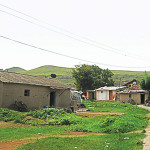- Two out of three Indian houses are in rural areas
- 6% of the houses in rural India are vacant
- A majority of rural houses, i.e., 77% are used solely as residences.
- 19.5% of houses have non-residential use i.e., grain stores, shops, cattle sheds etc.
- 0.3% are locked
- 3% are used as residences with other uses.
India lives in its villages. This oft-repeated maxim explains much of socio-economic realities of India. But how do the people in Indian villages live? Although the share of urban population in India went up from 27.80% in 2011 to 31.10% in 2011, India still remains overwhelmingly rural. Here are some facts:
Highlights
- Two out of three Indian houses are in rural areas
- 6% of the houses in rural India are vacant
- A majority of rural houses, i.e., 77% are used solely as residences.
- 19.5% of houses have non-residential use i.e., grain stores, shops, cattle sheds etc.
- 0.3% are locked
- 3% are used as residences with other uses.
Income Level
How prosperous, connected and accessible is Rural India. The data released from the Socio Economic and Caste Census (SECC) on the standard of living of rural households in India provides some insights into the state of rural people. The data from the 2011 Census was released by the Union finance Minister Shri Arun Jaitley in July 2015. The data provides the variables across the social spectrum too.
- Less than 5% of the rural households pay income tax. Even states that are considered rich i.e., Kerala, Tamil Nadu and Maharashtra, the number of IT payees hovers around 5% mark.
- In nearly 75% of rural households, the main earning members of the family earns less than Rs. 5,000 a month ($ 2.6) or Rs. 60,000 a year. In just about 8% households, the main earning members ears more than Rs. 10,000 a month.
- 72% of the rural households own a phone of some sort (mainly cellphone), only 11% own a fridge and 20% own a vehicle.
- The census found that only 3.62% of rural households across the country have a Kisan Credit Card with a credit limit of Rs. 50,000 or more.
- Over 90% of rural India, does not have salaried jobs. Over half of all rural households get their household income mainly from casual labour. Another 30% derive it from farming. This means that farming is yielding just enough for rural population to survive. This is called ‘subsistence level economy’.
- When the north of India is split into multiple zones “ north, east, central “ its rural areas are more prosperous than even the south. India’s east and central regions (including Uttar Pradesh) are the ones that do worst on the seven indicators identified by the SECC as measures of deprivation. Among the indicators, landlessness and a reliance on manual labour contributes the greatest to deprivation. In all, half of rural India is deprived on at least one of these indicators; what indicators to use to calculate poverty, though, is going to be a political choice.
- Chhattisgarh, Odisha and Madhya Pradesh perform abysmally when it comes to rural consumption of items measured in the census. A whopping 71% of Chhattisgarh’s rural population, for example, does not have a phone. This number is 65.3% for Odisha and 51.9% for Madhya Pradesh. The proportion of these States’ rural populations with a refrigerator is very low “ only around a third of the national average.
- The highest-paid members in an overwhelming 90.8% of rural households in Chhattisgarh earn less than Rs. 5,000 a month, which may explain the low consumption. This proportion is 87.8% in Odisha and 83.5% in Madhya Pradesh, against the national average of 74.5%.
- Over half of rural India owns no land at all. Among landless households, 40% is not irrigated. Just 4% own any sort of mechanized agricultural equipment and just 10% own any irrigation equipment. Fewer than 4% have an agricultural credit card that entitiels them to at least Rs. 50,000 per month.
- Most of the rural people cannot think of doing anything other than farming due to lack of education and skills. Fewer than 10% make it to higher secondary or above and just 3.41% of households have a family member who is at least a graduate.
- Fewer than SCs and STs have a main earner who makes more than Rs., 10,000 per month”for “others” the figure is twofold.
- Facilities
- 4.3% of the rural households do not have a separate bedroom.
- 39.4% of the households have just one room. 33.2% households have two rooms, 12.7% have three rooms, 6.6% have four rooms, 2.3% have five rooms, and 2.5% have six or more rooms.
- Less than 5% of rural households have more than two married couples.
- 3.6% of married couples do not have a separate room.
- 88.38% of the Indian households have at least one married couple.
- 16.34% and 10.85% of married couples in Karnataka and Tamil Nadu respectively, do not have separate room at home.
- 59.4% and 8.8% of households in rural and urban India, respectively had no latrine facilities. (NSSO sample survey in 2012)
- 26.3% and 47.1% households in rural and urban India, respectively, had dwellings units with ‘good ventilation’.(NSSO survey)
- 31.7% of rural households and 82.5% of urban households had ‘improved drainage’ facility in the environment of their dwelling units. (NSSO survey)
- 88.5% households in rural India and 95.3% households in Urban India had ‘improved source’ of drinking water. 85.8% in rural India and 89.6% in urban India had ‘sufficient’ drinking water. (NSSO Survey)
(Source: We have mainly depended upon Census 2011 statistics released in July 2015 for compiling this script. However, those that mention NSSO survey in bracket have been obtained from National Sample Survey Organisation survey conducted in 4,475 villages and 3,522 urban blocks spread across all over the country in July-December 2012)



COMMENTS